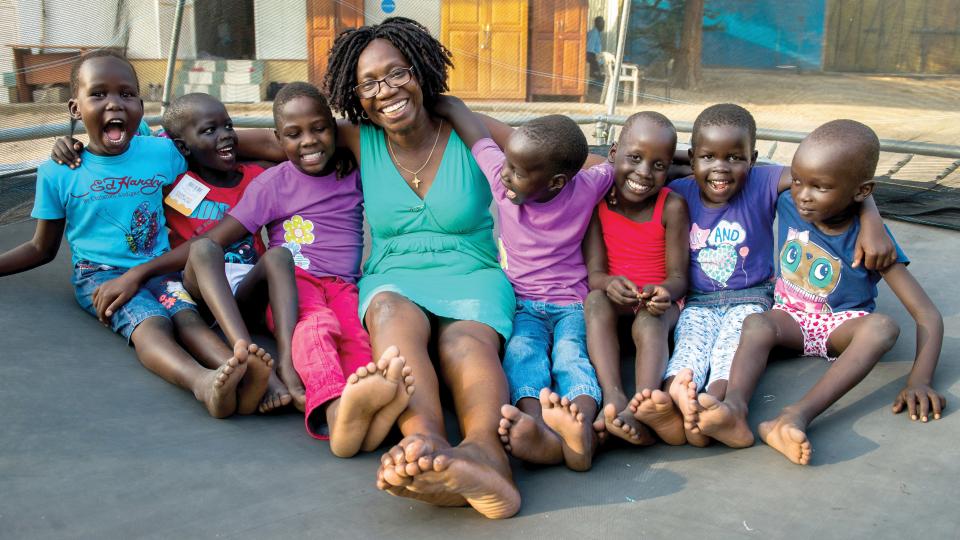The Lost (and now Found) Girls of Sudan

The girls were alone. Their families were dead, or gone, or lost in the broken landscape of southern Sudan. They had nowhere to turn, and no one to turn to. Some lived in the market, others in the cemetery. When Cathy Groenendijk saw them, she couldn’t help herself. She offered them tea, then some food, then a place to sleep in her guesthouse.
“In the morning, we would sit together and talk about what had happened the night before,” Groenendijk remembers. “And what I heard I could not believe. I could not believe it.”
One girl’s father had died, and after the funeral, she never saw her mother again. She was living on the streets with some other kids when four men started chasing them. The other girls were faster. She fell behind and was caught and raped by all four men. Groenendijk knew a doctor who repaired the physical damage, saving her life.
Another three girls, ages eight, six, and one, lived with their mother, but they all slept in the open. Groenendijk helped them build a tarped shelter, but the hot sun ate it away. One night, a man snuck in and tried to assault one of the girls. After that, Groenendijk let them sleep on her veranda.
This was in 2006. A peace accord had been signed the year before, ending a 22-year civil war and paving the way for the independence of South Sudan. But the region was still broken in many ways. While the story of its “lost boys,” who traveled hundreds of miles on foot to reach safety during the war, is well known, little has been written or said about the girls who stayed behind, and who were just as lost.
Groenendijk was born in eastern Uganda, where her father grew coffee and bananas on the family farm. She had three brothers and seven sisters, so when she was three years old, she was sent to the capital, Kampala, to live with an aunt. After secondary school, she went on to study nursing.
“When I was in Kampala,” she says, “I used to take the food that was left from our kitchen in the training school and give it to the children who were without food. It was a very, very bad time under Idi Amin, and after.”
It was a time of war, suspicion, and fighting. Between 1971 and 1979, about half a million people died under Amin’s dictatorship. Another 300,000 died under Milton Obote before he was deposed in 1985.
When she finished nursing school, Groenendijk got a job at a hospital in the north of Uganda. “There were so many militias and armed groups, especially among the northern tribes,” she says. “Even after the war, there were militias who were never fully disarmed. They were always fighting.”
Not long after she arrived, she met a young Dutch missionary named Wim, who worked with a relief organization called ZOA that aids people trapped in conflict and disaster zones. The two fell in love, got married, and for 10 years remained in Uganda, mostly in Karamoja, the remote northeast corner of the country.
In 1993, the couple went to the Netherlands. Shortly after they moved, the genocide in Rwanda began to unfold. An estimated 800,000 to 1 million people were killed in 100 days. When the violence subsided, a colleague at ZOA asked if Wim and Cathy would be willing to go to the country. Groenendijk would run a health program, and Wim would do agriculture and food security work in the town of Nyamata, south of Kigali. One of the most devastated areas, it’s now the site of a genocide memorial, at a church where 10,000 people who had gathered for protection were murdered.
Five months after the killing stopped, the couple arrived in Nyamata. Seeing how many children had lost their parents, they took in two foster children – girls who had lost their families. The girls still visit, and one will graduate from college this fall.
“The organization had little money to plan something positive for the children, like a party, to share together, to bring kids together,” Groenendijk says. “So I did a lot of children’s programs, in addition to working.”
In 1998, ZOA asked Groenendijk if she would help establish a health program in Sudan, which, on the map, was the largest country in Africa. In reality, though, it had never been much of a country at all. The south and the north were very different, and since 1955, animist and Christian groups in the south had been fighting for independence from the primarily Muslim north.
During the first war, which lasted until 1972, more than half a million people died. The south gained some autonomy, but when oil was discovered there in the late 1970s, war broke out again. From 1983 until 2005, an estimated two million people were killed; four million more fled to other countries or to camps for internally displaced people. In a country of 12 million, no one was unaffected.
When Groenendijk and her husband arrived in 1999, the fighting was still intense. They lived in rebel territory, in a village called Katigiri. “There were areas with no medical care at all,” she remembers. “Many people were dying.” They’d lived in conflict zones before, but this time was different. Planes bombed areas that had relief operations. “When we first arrived,” Groenendijk says, “we were bombed as were driving. Every house had foxholes, and when you heard planes flying over, you got out of the house and into the foxholes. We also had one large bomb shelter for everybody, but if a bomb landed on that one, there would be many casualties. So we used several foxholes to spread the risk.”
For nearly five years, she ran the ZOA health program in Katigiri. She made sure health workers were trained, medicines delivered, new health units opened, and transportation arranged for patients. All the while, the bombs kept coming as the war dragged on. When the danger and stress grew unbearable, the couple went back to Rwanda.
In 2005, a peace accord was signed and the fighting stopped. A date was set for a vote on independence. Groenendijk thought of the people she knew there, especially the children who’d lost so much. In 2006, she and Wim decided to return.

